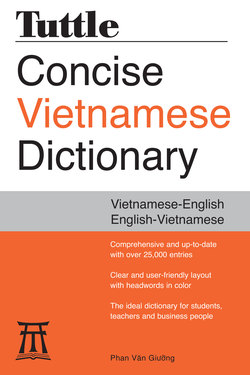Читать книгу Tuttle Concise Vietnamese Dictionary - Phan Van Giuong - Страница 8
На сайте Литреса книга снята с продажи.
ОглавлениеA Guide to Vietnamese Pronunciation
Like Chinese and Thai, Vietnamese is a tonal language where no word is conjugated. The Vietnamese alphabet has 29 letters:
a, aê, aâ, b, c, d, ñ, e, eâ, g, h, i, k, l, m, n, o, oâ, ô, p, q, r, s, t, u, ö, v, x, y.
The Vietnamese consonants are written as single letters or a cluster of two or three letters, as follows:
b, c, ch, d, ñ, g, gh, gi, h, k, kh, l, m, n, ng, ngh, nh, p, ph, qu, r, s, t, th, tr, v, x.
The vowels in Vietnamese are the following: a, aê, aâ, e, eâ, i/y, o, oâ, ô, u, ö. Vowels can also be grouped together to form a cluster or a word.
The following tables show the vowels and consonants in Vietnamese pronunciation with their English equivalents.
Tones
The standard Vietnamese language has six tones. Each tone is a meaningful and integral part of the syllable. Every syllable must have a tone. The tones are indicated in conventional Vietnamese spelling by diacritic marks placed over (aù, aø, aû, aõ) or under (aï) single vowels or the vowel in a cluster that bears the main stress (v).
Tone Symbols
The six tones just described are summarized in the following chart to illustrate the differences between them as they are associated with individual words.
The Vietnamese language has its national standard syntax, morphology and the tone system, although there are some regional variations in pronunciation and accents. The significant differences in pronunciation and accents between the Northern and Southern people (represented by Hanoi and Saigon respectively) are as follows:
1. There is no difference in the single vowels between Hanoi and Saigon.
2. There are two vowel clusters /öu/ and /öôu/ which are pronounced /iu/ and /ieâ u/ by Hanoi, and /öu/ and /öôu/ by Saigon.
3. Differences in the pronunciation of consonants:
4. Saigonese do not differentiate between the two tones /?/ and /~/; these are pronounced alike.
